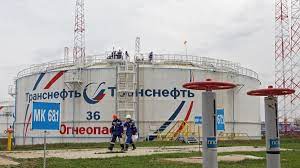Russia expects to get a huge inflow of energy revenue by the end of this year despite an oil price cap imposed by Group of Seven nations, and may channel it toward spending as the government continues to pour resources into the war in Ukraine.
In the last five months of 2023, total extra proceeds from oil and gas sales are estimated to reach 1 trillion rubles ($11 billion), according to two people close to the government with knowledge of the situation, who spoke on condition of anonymity. That amount is above a baseline level in the budget.
The Finance Ministry wants to put the additional income toward covering the budget deficit, the people said. Under a fiscal rule that was designed to insulate the economy from the volatility of commodity markets, windfall revenue should be used to buy foreign currency for the National Wellbeing Fund’s reserves.
The Finance Ministry on Thursday signaled it may change its rules. “The government may consider reducing the use of the National Wellbeing Fund for financing additional federal budget expenditures in the transition period of 2023-2024,” the ministry said in a website statement, without proposing an alternative source of funding.
That may mean the ministry will turn to the extra energy revenue and review the budget mechanism introduced this year to cushion the blow from sanctions, according to Olga Belenkaya, an economist at Finam.
“Revising the budget rule too frequently in response to changing circumstances may weaken the market’s confidence,” she said. “It could undermine its main idea — avoid the use of oil and gas windfall revenues to finance spending beyond the limits of the National Wellbeing Fund.”
State spending has surged to record levels as the Kremlin boosts defense production and social programs to support its war in Ukraine and maintain public backing for President Vladimir Putin. Russia gets around a third of its budget revenues from the oil and gas industry.
The sharp depreciation in the Russian currency has boosted ruble proceeds. The ruble has weakened 22% against the dollar so far this year and is at its lowest level since March last year. Each ruble decline against the dollar means 100 billion-120 billion rubles in additional revenue for the government, Bloomberg Economics Russia economist Alexander Isakov said.
The federal budget ran a monthly surplus in June for the first time this year, helping to shrink the deficit to 2.6 trillion rubles so far in 2023. Russia’s flagship Urals crude also breached the $60 per barrel price cap last month set by the G-7 nations to try to restrict funding for the war effort, with India and China as major consumers.
What Bloomberg Economics says…
Government’s decision to divert windfall oil tax revenue from replenishing its National Wealth Fund to funding current spending will mean two things. On the one hand, this will leave more scarce FX to the private sector and thus will take some pressure off the ruble and inflation. On the other hand, this means Russia is removing the key mechanism it used to immunize its currency against oil price shocks – the fact that extra revenue will fund spending means the ruble will follow oil more closely than in recent years.
For now, the Finance Ministry said it will resume buying foreign currency and gold for the National Wellbeing Fund as the recovery in monthly revenues from oil and gas exports brought it above the target set in the budget. It will purchase 40.5 billion rubles during the Aug. 7-Sept. 6 period, according to a statement Thursday.

 Iran Energy News Oil, Gas, Petrochemical and Energy Field Specialized Channel
Iran Energy News Oil, Gas, Petrochemical and Energy Field Specialized Channel



